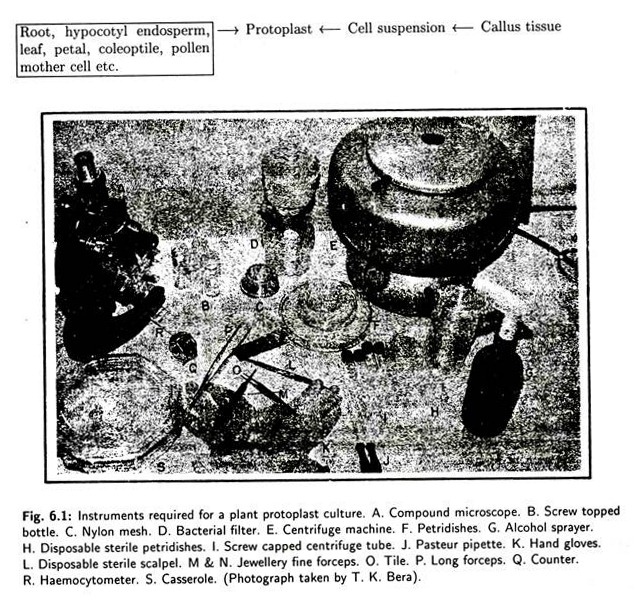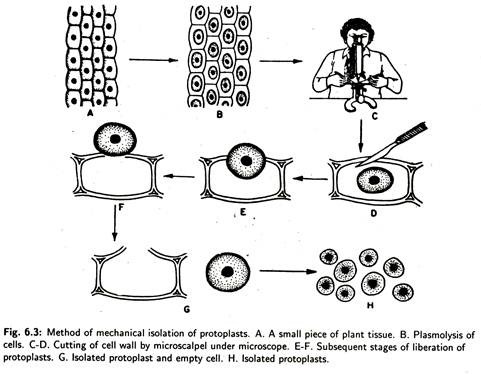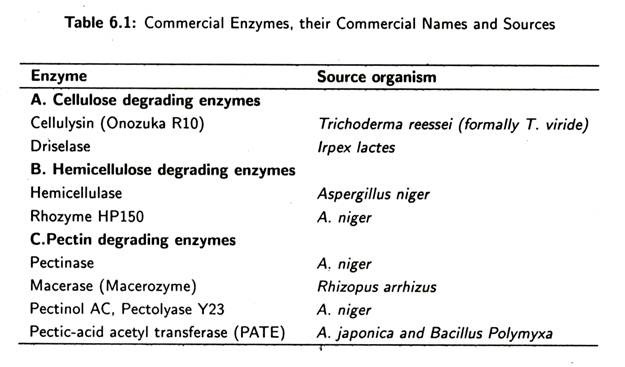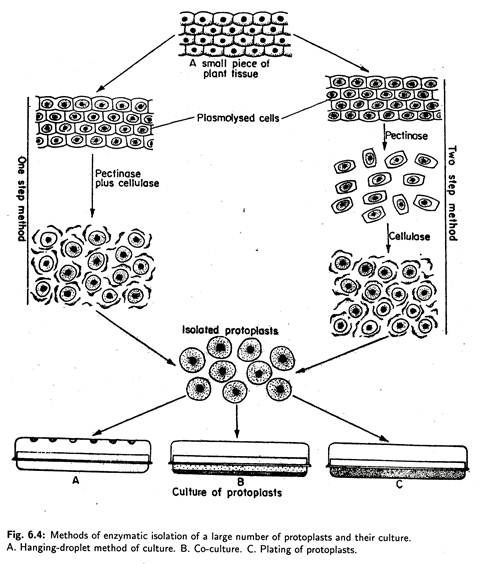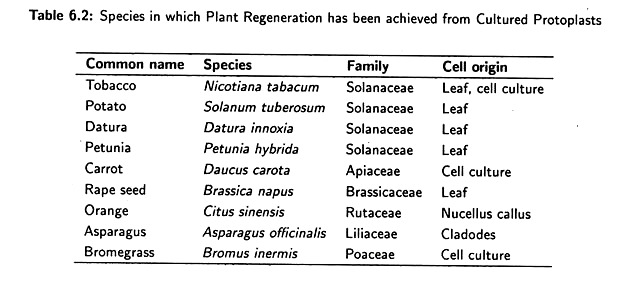In this article we will discuss about Protoplasts:- 1. Definition of Protoplast 2. Brief Past History 3. Different Sources of Plant Tissue and their Conditions for Protoplast Isolation 4. Principles of Protoplast Culture.
Definition of Protoplast:
It is known that each and every plant cell possesses a definite cellulosic cell wall and the protoplast lies within the cell wall except some reproductive cells and the free-floating cells in some fruit juices like coconut water.
Therefore, protoplast of plant cell consists of plasma lemma and everything contained within it. But those of importance to plant protoplast culture are produced experimentally by the removal of cell wall by enzymatically or mechanical means from the artificially plasmolysed plant cells. Experimentally produced protoplasts are known as isolated protoplasts.
According to Torrey and Landgren (1977) “the isolated protoplasts are the cells with their walls stripped off and removed from the proximity of their neighbouring cells”. Vasil (1980) defines that “the protoplast is a part of plant cell which lies within the cell wall and can be plasmolysed and which can be isolated by removing the cell wall by mechanical or enzymatic procedure”.
Therefore, isolated protoplast is only a naked plant cell surrounded by plasma membrane, which is potentially capable of cell wall regeneration, cell division, growth and plant regeneration in culture.
Brief Past History of Protoplast:
J Klercker (1892):
First isolated protoplast mechanically from plasmolysed cell of water barrier (Stratiotes aloides). No attempt was made to culture them.
E Kiister (1927):
In the fruits of several plants like Solanum nigrum, Lycopersicon esculentum etc. the cell walls are hydrolysed during fruit-ripening process so that free protoplasts and protoplasmic units are left. Kiister preferred such physiological method for isolating protoplasts. No report of culture was available.
R Chambers and K Hofler (1931):
Were able to isolate few protoplasts by using thin slices of epidermis of onion bulb immersed in 1M sucrose until the protoplast shrunk away from their enclosing walls and then cutting sheets of epidermis with a sharp knife. Report of culture was not available.
E C Cocking (1960):
First reported the enzymatic method for isolation of protoplast in a large number from root tip cells of Lycopersicon esculentum by using a concentrated solution of cellulase enzyme, prepared from cultures of the fungus Myrothecium verrucaria to degrade cell wall.
I Takebe, Y Otsuki and S Aoki (1968):
First employed the commercial preparation of cellulase and macerozyme sequentially (in two steps) for the isolation of mesophyll protoplast of tobacco.
J B Power and E C Cocking (1968):
Demonstrated first that the mixture of two such enzymes (cellulase + macerozyme) can be used simultaneously (one step method) for the isolation of protoplasts.
I Takebe, G Labib, G Melchers (1971):
First reported the plant regeneration from isolated protoplast in Nicotiana tabacum.
P S Carlson, H H Smith, R D Dearing (1972):
First reported a somatic hybrid in higher plants involving two different sexually compatible species of mesophyll protoplast (N glauca + N langsdorffi).
Different Sources of Plant Tissue and their Conditions for Protoplast Isolation:
Protoplast can be isolated either directly from the different parts of whole plant or indirectly from in vitro cultured tissue. Convenient and suitable materials are leaf mesophyll and cells from liquid suspension cultures. Protoplast yield and viability are profoundly influenced by the growing conditions of plants serving leaf mesophyll sources.
The age of the plant and of the leaf and the prevailing conditions of light, photoperiod, humidity, temperature, nutrition and watering are contributing factors. Cell suspension cultures may provide a more reliable source for obtaining consistent quality protoplasts. It is necessary, however, to establish and maintain the cells at maximum growth rates and utilize the cell at the early log phase.
Principles of Protoplast Culture:
The basic principle of protoplast culture is the aseptic isolation of large number of intact living protoplasts removing their cell wall and culture them on a suitable nutrient medium for their requisite growth and development.
Protoplast can be isolated from varieties of plant tissues. Convenient and suitable materials are leaf mesophyll and cells from liquid suspension culture. Protoplast yield and viability are greatly influenced by the growing condition of the plant as well as the cells.
The essential step of the isolation of protoplast is the removal of the cell wall without damaging the cell or protoplasts. The plant cell is an osmotic system. The cell wall exerts the inward pressure upon the enclosed protoplasts. Likewise, the protoplast also puts equal and opposite pressure upon the cell wall.
Thus, both the pressures are balanced. Now, if the cell wall is removed, the balanced pressures will be disturbed. As a result, the outward pressure of protoplast will be greater and, at the same time, in absence of cell wall, irresistible expansion of protoplast takes place due to huge inflow of water from the external medium.
Greater outward pressure and the expansion of protoplast cause it to burst. So, the isolated protoplast is an osmotically fragile structure at its nascent stage.
Therefore, if the cell wall is to be removed to isolate protoplast, the cell or tissue must be placed in a hypertonic solution of a metabolically inert sugar such as mannitol at higher concentration (13%) to plasmolysis the cell away from the cell wall (Fig. 6.2).
Mannitol, an alcoholic sugar, is easily transported across the plasmodesmata, provides a stable osmotic environment for the protoplasts and prevents the usual expansion and bursting of protoplast even after loss of cell wall. That is why this hypertonic solution is known as osmotic stabilizer or plasmolyticum or osmolyticum.
Once the cells are stabilized in such a manner by plasmolysis the protoplasts are released from the containing cell wall—mechanically or enzymatically. Mechanical isolation (Fig. 6.3) involves breaking open each cell compartment to liberate the protoplast.
This operation can be done carefully on small pieces of tissue under a microscope using a micro-scalpel. But very few protoplasts are obtained in a lot of time and effort. Large-scale attempts at mechanical isolation involves the disrupting tissue with fine stainless steel-bristled brush.
This process may liberate more protoplasts with less effort, but the percentage of yield of intact protoplasts is still very low. A considerably more efficient way of liberating the protoplasts is to digest the cell walls away around them, using cell wall degrading enzymes such as cellulase, hemicellulase, pectinase or macerozyme etc. These enzymes are isolated from fungi and available commercially (Table 6.1).
Period of treatment and concentration of enzymes are the critical factors and both factors should be standardised for particular plant tissue. Intact tissue can be incubated with a pectinase or macerozyme solution which will dissolve the middle lamella between the cells and so separate them.
Subsequent treatment with cellulase will digest away the cellulosic layer of the cell wall. This process is known as sequential enzyme treatment or two step method as opposed to a mixed enzyme treatment (one step method) in which both cellulase and pectinase or macerozyme are mixed so that the entire wall is broken down in a single operation (Fig. 6.4).
The isolated protoplasts can be cultured in either static liquid or agarified medium. The protoplast media consist of mineral salts, vitamins, carbon sources and plant growth hormones as well as osmotic stabilizers and, possibly, organic nitrogen sources, coconut milk and organic acids. In culture, protoplasts can reform a new cell wall around them. Once the wall is formed, the protoplast becomes a cell.
The cells from protoplasts subsequently enter cell division which is followed by the formation of callus and cell cultures. Such callus also retain the capacity for morphogenesis and plant regeneration.
A brief list of plant regeneration from plant protoplast culture is given below (Table 6.2):
